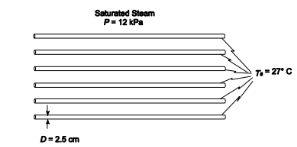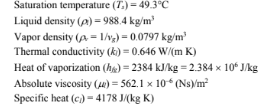At their closest approach, Venus and Earth are 4.20 × 1010 m apart. The mass of Venus is 4.87 × 1024 kg, the mass of Earth is 5.97 × 1024 kg,
and G = 6.67 × 10-11 N ? m2/kg2. What is the magnitude of the gravitational force exerted by Venus on Earth at that point?
A) 1.10 × 1018 N
B) 4.62 × 1028 N
C) 5.43 × 1026 N
D) 6.30 × 1020 N
E) 1.72 × 1019 N
A
You might also like to view...
Which spacecraft was the first to photograph Uranus in 1986?
a. Hubble Space Telescope b. Cassini-Huygens c. Cassini-Huygens d. Voyager 2 e. New Horizons
Repeat Problem 9.23 for a tier of six horizontal 2.5-cm-OD tubes under similar thermal conditions.
GIVEN
? Saturated steam condensing on horizontal tubes
? Tube outside diameter (D) = 2.5 cm = 0.025 m
? Tube outer surface temperature (Ts) = 27°C
? Steam pressure (p) = 12 kPa
? Number of tubes (n) = 6
FIND
? The average heat transfer coefficient (hc)
ASSUMPTIONS
? Steady state
? Film condensation occurs
SKETCH

PROPERTIES AND CONSTANTS
From Appendix 2, Table 13, for saturated water at 12 kPa

A vehicle designed to operate on a drag strip accelerates from zero to 30 m/s while undergoing a straight line path displacement of 60 m. What is the vehicle's acceleration if its value may be assumed to be constant?
a. 2.0 m/s2 c. 10 m/s2 b. 7.5 m/s2 d. 15 m/s2
An uncharged spherical conducting shell surrounds a charge ?q at the center of the shell. The charges on the inner and outer surfaces of the shell are, respectively,
A. ?q, ?q. B. ?q, +q. C. +q, ?q. D. +q, +q. E. +q, 0.